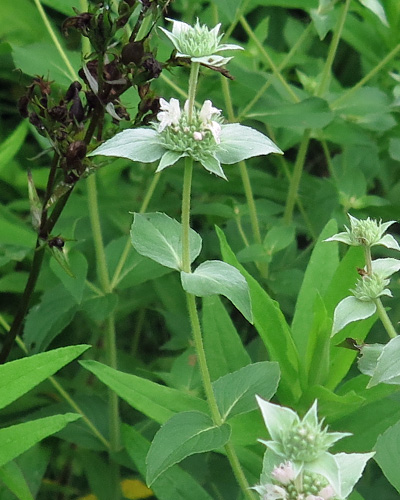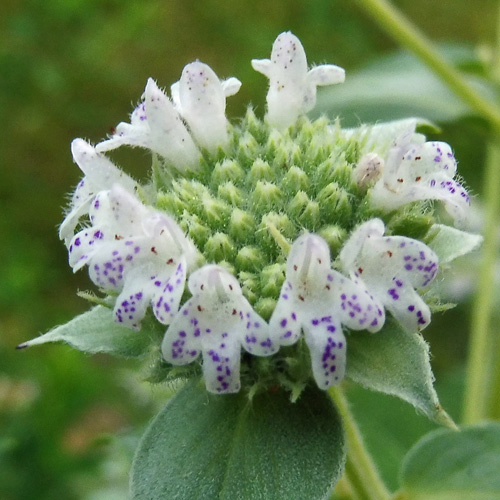Home Resources Gardener News reprints: Broad-leaved Mountain Mint, Pycnanthemum muticum
This article by Hubert Ling (NPSNJ horticulture) was published in Gardener's News without the photos. He is a regular contributing writer to Gardener's News. Photos by H & M Ling.
Mints: Mountain Mints
You might think peppermint or spearmint but did you know that New Jersey has almost 80 types of mints? Well I didn’t either but my detailed reference books make me look good! About half of these NJ mints are recent immigrants and half are native.
Mints generally have leaves arranged in pairs opposite each other on square stems, small flowers in terminal clusters, and leaves dotted with glands containing aromatic oils which give mints distinct aromas. Mints and New Jersey are perfect together since these oils often discourage deer.
Native mint plants come in all sizes and shapes from a diminutive 4 inch blue curls to a 7 foot yellow giant hyssop. Other colors include purple, white, and the vivid color of bee balm. Almost nothing can make a hike more memorable then chancing upon a bed of pure red bee balm gracing the banks of a meadow stream; we will try and feature this treasure and its relatives in a future article.

Now that you know there is much more than just peppermint let’s look at the mountain mints or Pycnanthemum found in NJ; Pycnanthemum, the scientific name, means densely crowded with flowers.
Yes mountain mints are frequently found on mountains such as High Mountain Park Preserve in Passaic County, which has 4 types, but they are also commonly found at lower elevations sharing meadows with grasses, thistles, and asters.
Four NJ native, perennial, mountain mints are commonly available for sale: P. incanum (hoary), P. muticum (short-toothed), P. tenuifolium (narrow-leafed), and P. virginianum (Virginia mountain mint). These species have similar growth requirements and similar characteristics. I will specifically discuss short-toothed mountain mint since I have been growing this plant for several years but the information presented here can generally be applied generally to all.
Mountain mint grows to 2-3 feet tall. In late July through early September it produces numerous clusters of small white flowers with violet speckles. The flowers open up over a 4-6 week span and are avidly sought by a variety of butterflies, moths, bees, and flies. The flowers are highlighted by showy rosettes of pale green leaves. NABA, the North American Butterfly Association has a rousing recommendation for the mountain mints on its web pages.

Short-toothed mountain mint has a lot of mint oils and is very fragrant. North American natives used the leaves of mountain mints for headaches and amenorrhea and early settlers in the US used them for colds, fevers, sore throats, colic, and stomach cramps. However, several of the broad-leafed mountain mints contain pugelone which can damage your liver if ingested in large amounts. So instead of using mountain mint in your mint tea PETA (People for the Ethical Treatment of Animals) suggests you use it to humanely repel mice. Many people have also experimented with various mints as insect repellants and sprayed it on plants as a natural insecticide but use a little caution at first since you or your favorite plant may have a sensitive epidermis.
Mountain mints are very easy to grow on a variety of slightly acid to neutral soils in sun or partial shade. Colonies expand slowly by runners and large clusters can be divided in spring or fall. In addition, the seeds can be collected in fall and sown immediately. Be sure to collect the seeds early; the seed capsules of mints mature rapidly and release all their minute seeds when they just start turning golden. If you wait until all the seed capsules are brown you will find the seeds long gone.
I start collecting seeds in August to September when some capsules of a cluster are brown, most are yellow and some are still green. Use a seed tray ¾ filled with good garden soil. Depress the center of the soil to prevent the seeds from washing overboard. Mix 2 pinches of seed with ¼ cup of dry soil (to ensure even coverage), sprinkle over the seed tray, and pat down. A mulch of straw or oak leaves will also help protect the seeds from driving rain. Remove the mulch in April and celebrate your effort to make NJ a little better.